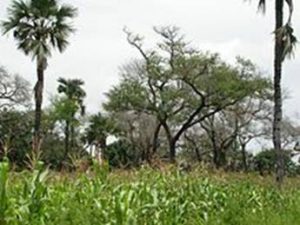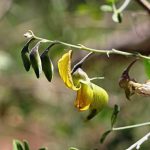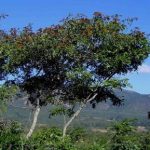TREE LIFE
JANUARY 2010
MASHONALAND CALENDAR
Sunday, January 17th: Blue Haze Lane, Umwinsidale. We will meet at 9.30 a.m. Please bring a chair and your lunch.
*** NOTE: EXTRA EVENT ***
Saturday, January 23rd: Visit to the National Herbarium. As a follow-up to the successful appeal for the fumigation of the National Herbarium, we have organised an afternoon visit to the herbarium for Tree Society members and people who donated to the appeal.
The purpose of the visit will be to show people the Herbarium and what it does.
The Head of the Herbarium, Christopher Chapano, will be there to give us a guided tour of about 30 minutes in length. Afterwards, we will arrange some tea (ZESA willing) and there will be an opportunity to look more closely at the specimens and facilities. This event will take place on Saturday 23rd January at 2.30 p.m.
The entry to the National Herbarium is off 5th Street Extension, opposite Downie Avenue. NOTE that this is not the place where we usually meet for Tom’s walks. Please could those intending to attend let our Secretary, Ruth Evans (petra@mango.zw) know in advance so that we have some idea of the numbers who will be coming.
LETTER TO TREE LIFE
[Rob Burrett has sent us some comments that expand usefully on the themes about Harare trees and history in the December Tree Life. -Ed.]
Yes, for many years it has been known that the Harare hanging tree was a myth. No one was hanged there … certainly not Nehanda. It is a myth that has been around for many years, but it got worse when that stamp was issued (without the facts being checked with heritage specialists); it also suits the current reinvention of nationalist heritage. National Museums is fully aware of this myth. It is correct that Nehanda and the others were hanged at what is now Harare Central – that section that corners on Kenneth Kaunda Avenue. It has a large internal open space, and it was probably there.
On the Miombo of Harare there are several points:
1. Most pictures are taken from the Kopje looking out over the vlei that was around the stream that now runs under the palms of Julius Nyerere Way. It was a large, open and grassy area that was chosen. Yes, damp in places, but desirable for reason of defense for the Pioneers who were concerned about potential Matabele attack. If they had gone on to Mount Hampden, as was the aim, it would have been through problematic terrain and treed relief – much too dangerous. The Miombo was there, but it did not appear in the lens of those early photographers.
2. Vleis were also larger then as the water tables had not been drained, something we have done so successfully in the last century. You know how the margins of most of the remaining grass belts around Harare (Greystone Park for example) have been invaded as we alter the water table level. This seems to be a general phenomenon and, with ten boreholes reportedly being drilled in Harare every day, is a situation that can only worsen.
3. In addition, this area was occupied during the late pre-colonial period. There were villages in the area, and the inhabitants would have used the timber and opened fields.
4. I think we saw the re-emergence of Miombo through the colonial process. It was there, but in pockets up on the more exposed highveld – hammered by nature, humans and frost. Look at those old musasa in the Botanical Gardens or at Saint George’s College. They must be a few hundred years old. Regrowth and expansion took place successfully with our intervention.
5. A really good example of the changing cycles influenced by humanity is the Epworth-Ventersburg area. In the 1890s, Alice Balfour painted rocks and people just off the “Umtali Road”. The background is grassy plain with few trees. Then it became private land, and the Miombo reasserted itself, or it invaded so that a well-treed section was established along the Marondera Road. I remember us going there when it was a leased commercial farm some years back. It was good Miombo. Then came the expansion of informal settlement and the ZESA challenges; the trees went, and we are back to Balfour, albeit with maize and a LOT more people!
It would be interesting to see this analysed scientifically by someone. Similar patterns occur in Bulawayo, Gweru and Marondera, where I have early pictures.
R. Burrett.
Faidherbia albida Promises to Revive African Soils
[One paper presented at last August’s 2nd World Congress of Agroforestry in Nairobi received particular attention, and stories reporting its findings were published widely. The one used here comes from Science Daily of August 26, 2009. (https://www.sciencedaily.com/releases/2009/08/090824182535.htm).
-Ed.]
With its nitrogen-fixing qualities, the tall, long-lived acacia tree, Faidherbia albida (Mgunga in Swahili) could limit the use of fertilizers; provide fodder for livestock, wood for construction and fuel wood, and medicine through its bark, as well as windbreaks and erosion control to farmers across sub-Saharan Africa. The tree illustrates the benefits of growing trees on farms, said the scientists at today’s meeting, and is adapted to an incredibly wide array of climates and soils from the deserts to the humid tropics.

Faidherbia albida growing with palms and maize Photo: Wikipedia
“The future of trees is on farms,” said Dennis Garrity, Director General of the World Agroforestry Centre, or ICRAF, one of 15 centres supported by the Consultative Group on International Agricultural Research (CGIAR). The Centre is hosting the Congress, which has convened about 800 global experts to discuss the importance of growing trees on farms for humanity’s survival.
“Growing the right tree in the right place on farms in sub-Saharan Africa and worldwide has the potential to slow climate change, feed more people, and protect the environment. This tree, as a source of free, organic nitrogen, is an example of that. There are many other examples of solutions to African farming that exist here already.”
African farmland is severely degraded and African farmers, on average, apply only 10 percent of soil nutrients used in the rest of the world. Low-cost options are critical to reversing the continent’s declining farm productivity, the scientists said, as sharply increasing fertilizer prices further limit the choices African farmers have to improve farm yields while protecting forests from further clearing.
The Faidherbia acacia tree has the quality of “reverse leaf phenology,” which drives the tree to go dormant and shed its nitrogen-rich leaves during the early rainy season – when seeds are being planted and need the nitrogen – and then to re-grow its leaves when the dry season begins and crops are dormant. This makes it highly compatible with food crops because it does not compete with them for light – only the bare branches of the tree’s canopy spread overhead while crops grow to maturity. Their leaves and pods provide a crucial source of fodder in the dry season for livestock when other plants have dried up.
Research on the tree began over 60 years ago when scientists observed that farmers throughout the Sahelian region of Africa were retaining the trees in their sorghum and millet fields. It is a frequent component of farming systems of Senegal, Mali, Burkina Faso, Niger, Chad, Sudan, and Ethiopia, and in parts of northern Ghana, northern Nigeria, and northern Cameroon. The tree is growing on over 4.8 million hectares of land in Niger. Half a million farmers in Malawi and in the southern highlands of Tanzania grow the tree on their maize fields.
In Malawi, maize yields were increased up to 280 percent in the zone under the tree canopy compared with the zone outside the tree canopy. In Zambia, recent unpublished observations showed that unfertilized maize yields in the vicinity of the Faidherbia trees averaged 4.1 tonnes per hectare, compared to 1.3 tonnes nearby but beyond the tree canopy. Yield increases have also been documented in unfertilized millets grown under the tree in West Africa, for sorghum in Ethiopia, other parts of Africa, and in India, in addition to groundnuts and cotton. Often, millet and sorghum exhibit no further response to artificial fertilizers beyond that provided by the tree’s leaf fall.
Currently, the Departments of Agriculture in both Malawi and Zambia are seeking to double maize production with the use of the tree. They recommend that farmers establish 100 Faidherbia trees on each hectare of maize that is planted.
Scientists at the conference noted some 700 published references to the tree’s history, ecology, and growing habits. “Knowledge of this tree is farmer-driven,” said Garrity. “We are now combining the scientific knowledge base with the farmer knowledge base. There is sufficient research on both sides to warrant dramatically scaling-up the planting of this tree on farms across Africa through extension programs. The risks to farmers are low; it requires very little labour, and delivers many benefits.”
“Thus far we have failed to do enough to refine, adapt and extend the unique properties of these trees to the more than 50 million food crop farmers who desperately need home-grown solutions to their food production problems,” he continued.
A Green(ish) New Year’s Quiz
Happy New Year! You will have had Adele’s usual challenging quiz at the Christmas social. Now, as a test of how much self-inflicted damage you did to yourselves over the festive season, here is a baker’s dozen for the New Year. Bearing the theme in mind may prove helpful.
- What two (large) birds are known to make therapeutic use of what widespread local tree? And how?
- Where do the original wild apples and apricots come from?
- And in the same vein, what is the only fruit that we see regularly on sale in many places that comes originally from southern Africa?
- Of all vegetables, only three will routinely crop for several growing seasons. All other vegetables must normally be replanted every year. What are the three perennial vegetables?
- In posh liquor stores, it is possible to buy pear brandy with a real pear inside the bottle. The pear is whole and mature, and the bottle is genuine, but has a neck much smaller than the pear. Neither bottle nor pear has been cut in any way. How did the pear get in there?
- Name the only vegetable that is never sold (at least in southern Africa) frozen, canned, processed, cooked or in any other form except fresh.
- Name the only fruit that has its seeds on the outside.
- Name a fruit where you eat the stalk and treat the actual fruit with great reserve at best.
- A Russian novelist and Nobel Prize winner; a German Chancellor, and an American filmmaker share common roots. What’s the connection?
- Why would good gardeners celebrate the incoming of 2010 with the root of a sedge, 2011 with the bluebells of Scotland, and 2012 with a tree that drips blood?
- What is reputed to be the second most frequent cause of accidental death in the Comoros, after traffic accidents?
- Where does the common name of the weed Chromolaena come from, and why is it appropriate?
Finally, let’s see who knows their grasses:
- Name five important food grasses.
- How do grasses cause hay-fever?
- What are marram grass and esparto grass used for?
- Are pampas grass and bamboo true members of the grass family?
That’s it folks! Answers in January’s Tree Life.



